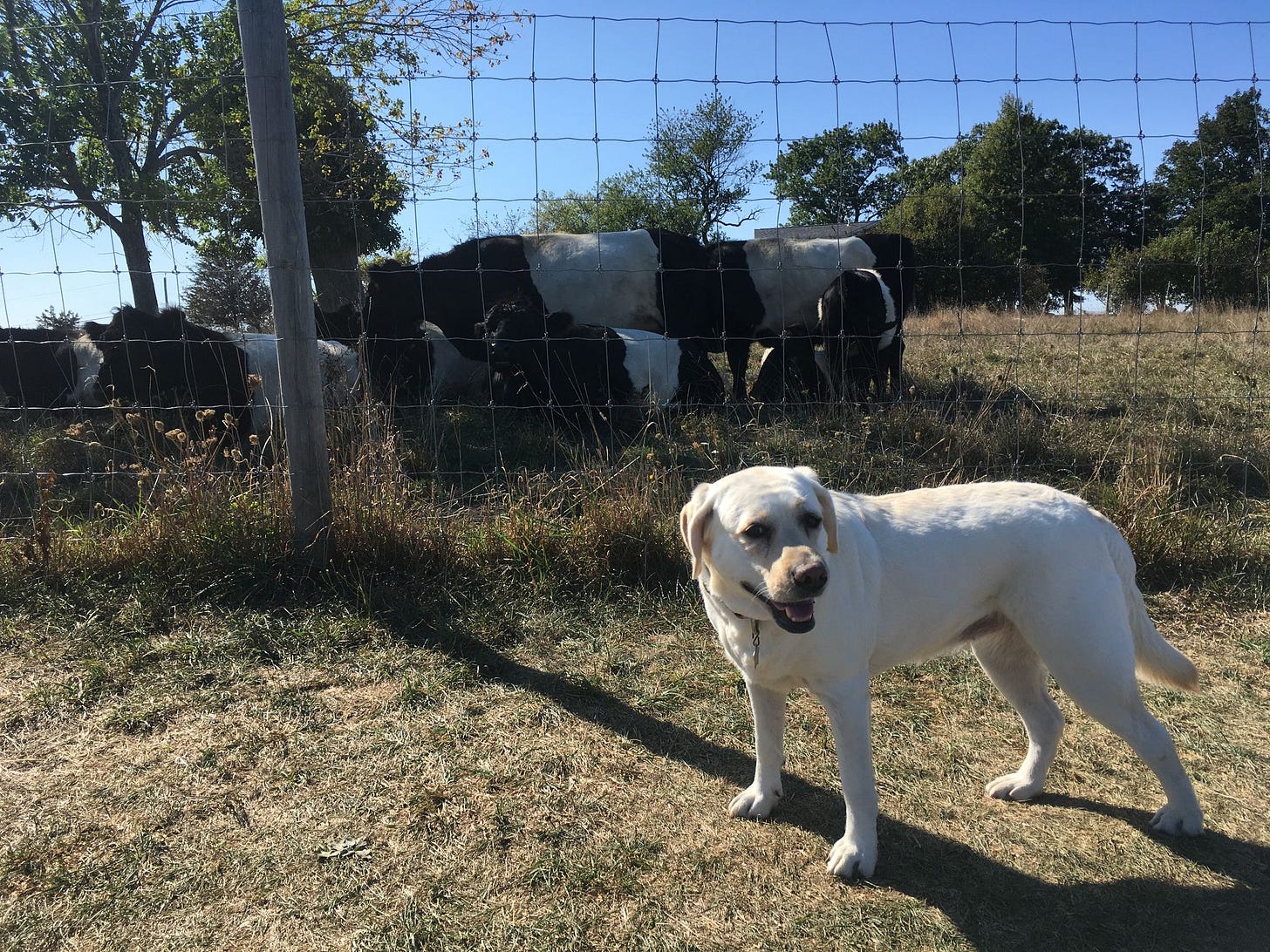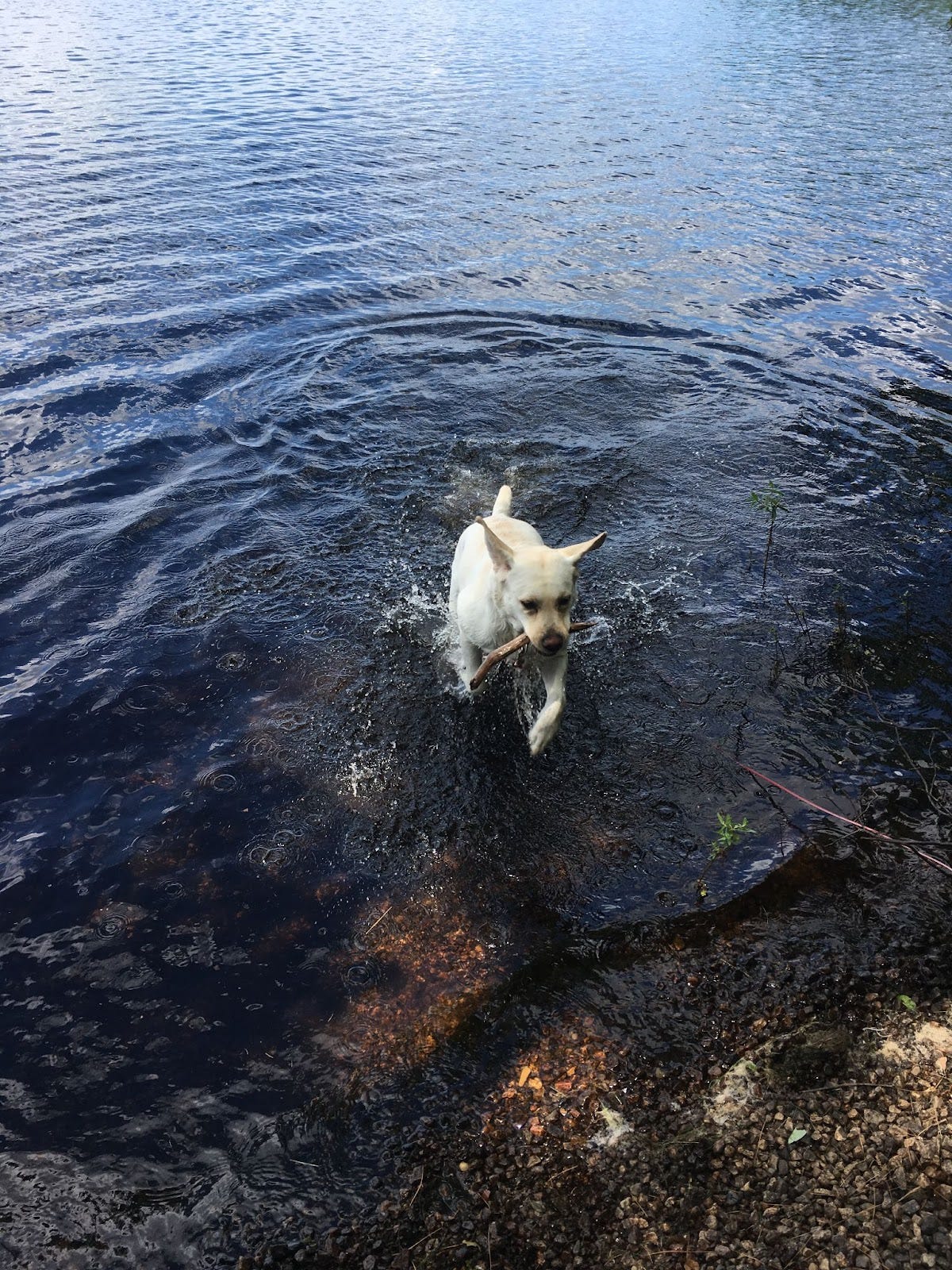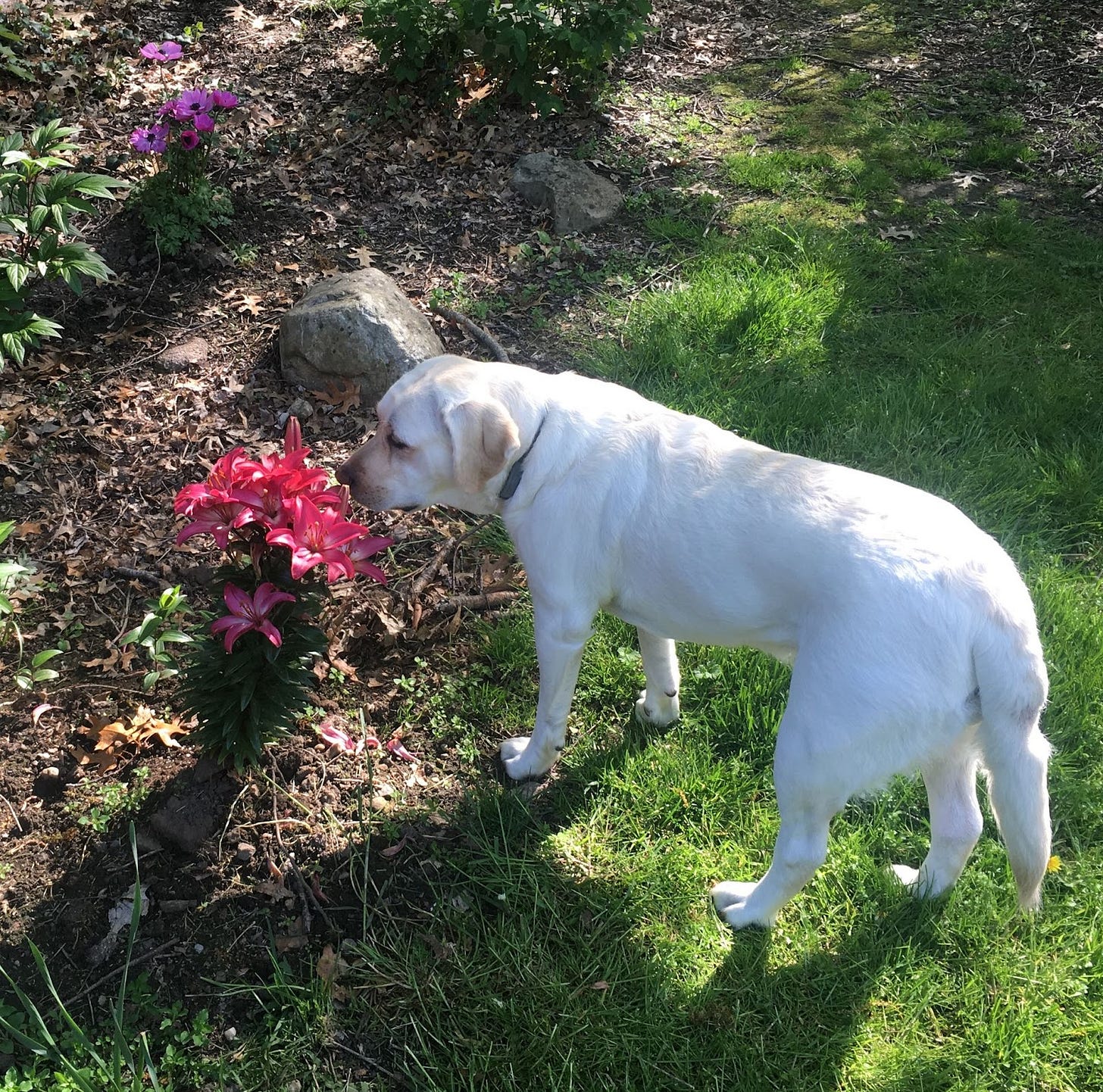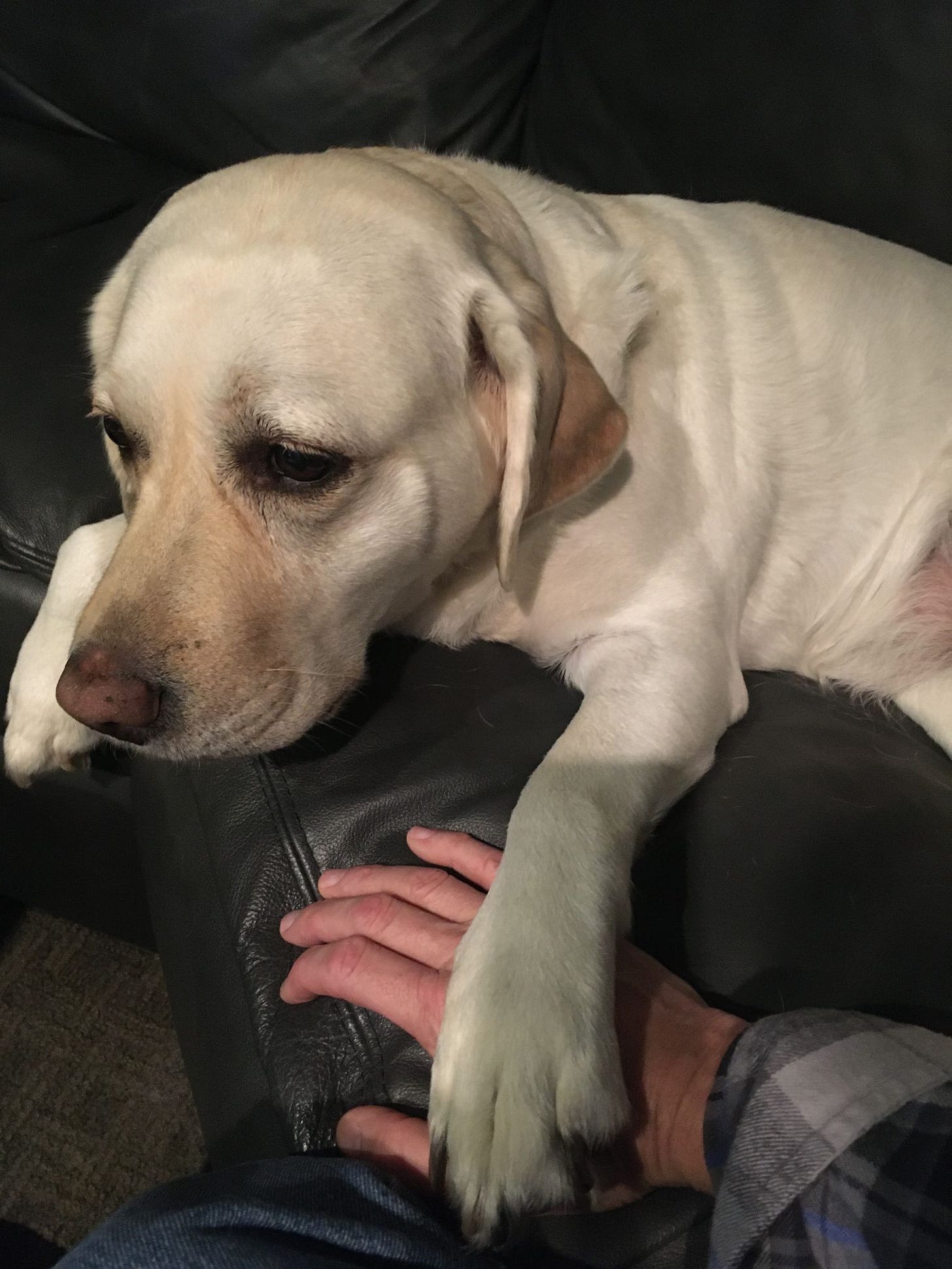“I give her four to six weeks,” said the veterinarian. Dr. Kathy Sneider had instructed me to come directly to her house so that she could take X-rays of Hannah, my 11-year-old labrador retriever, that Saturday morning. In the X-ray Dr. Sneider pointed out the location of Hannah’s liver, her heart, and made mention of her stomach filled with food which she said was a promising sign. She also pointed out Hannah’s spleen which she identified as being larger than normal. Dr. Sneider also took note of what appeared to be a growth on Hannah’s spleen, although she did say that it was hard to pinpoint exactly what this mass was due to an intestine that was partially in the way of an otherwise perfectly clear view. I helped Hannah down from the lab table while the vet and I continued talking. “You have some decisions to make,” said Dr. Sneider.
This ordeal had begun days before this appointment with Dr. Sneider when I returned home one afternoon to an extremely uncharacteristic situation. Hannah did not meet me at the door as she usually does, nor did she raise her head up over the arm of the couch disturbed from her sleep by the noise of my key opening the door. Instead, she was curled up in a corner between the television and a rocking chair, choosing to stay on the floor with a blank stare rather than her normal ritual of jumping up to greet me. Close by I could see that Hannah had also had an accident on the carpet, something she has never done. In an effort to alleviate any further anxiety that the dog might already be having from the incident, I acted deliberately calm while quickly cleaning the carpet. I took Hannah outside, and when we came back in the house she went directly to her bowl for dinner as she normally does. But on this day she was not interested in eating. Likewise, she would not jump up to her normal place on the couch, so I lifted her onto the spot where she usually naps and stayed with her for a while. Within an hour, Hannah suffered through a relatively long seizure. This was not completely out of the ordinary as she has been having seizures her whole life and is on medication to minimize them, but I was concerned about this particular seizure on the heels of whatever happened before I walked through the door that afternoon. I called Hannah’s vet at Blue Ribbon Veterinary Services in Pembroke, Massachusetts, to provide them with an update and to hopefully receive some direction. Fortunately, Dr. Kathy Sneider has known Hannah for all eleven years of her life along with Hannah’s entire genealogical family, so her care and concern as a vet is often as familial as it is medical. Dr. Sneider’s advice was to monitor Hannah carefully throughout the night, and in the event of a medical emergency before the morning I was told to get her to an animal hospital immediately.
Hannah’s disposition began to normalize as the hours progressed. She occasionally attempted to eat from her bowl, although usually abandoning the idea after a quick bite or two. Later that night, she jumped onto my bed and slept there as opposed to her own normal bed that sits on the floor just below where I sleep. Hannah’s normal routine in the morning consists of waking up early, usually no later than 4:45 a.m. When she is sleeping in her own bed on the floor, she jumps up on the bed with her two front paws to wake you up. If she sleeps at the end of my bed, she normally crawls up close enough to reach out and touch your face with her paw, forcing you to open your eyes to find a dog staring at you from inches away sometimes with her head resting on the pillow beside you. But this was not a normal morning. Hannah remained at the end of my bed with the same blank stare that she had when I came home the day before. I helped her down to the floor, a jump she can usually make with relative ease. I assumed that her physical reaction was probably due to another seizure during the night meaning that she had now suffered three possible seizures in only 24 hours. A visit to the vet was definitely in order. I scheduled a quick appointment at 9:30 that morning. By the time we arrived at the vet, Hannah was appearing to return to her normal self. As opposed to most dogs, Hannah actually enjoys going to the vet. To Hannah, Dr. Sneider is like an old friend that has a jar full of treats at every corner as long as you agreeably get on a scale to be weighed and sit patiently while blood is taken. We had just been in for her annual physical about two weeks before this emergency check-up, so she was more than acclimated to the drill. The vet took Hannah’s temperature and she also took blood, just as she had done during her physical. We were on our way home in no time leaving the vet’s office with nothing obvious to be concerned about. Always caring, Dr. Sneider gave me her cell phone number on a scrap of paper and instructed me to call her directly if there was an emergency.
Comparatively, Hannah had a good day after returning from the vet. But when we got up early the next morning, Hannah threw up much of what she had managed to eat or drink during the two days before. Concerned about her ability to eat, I left a recorded message with the vet’s office so that they were aware. Dr. Sneider later called me back from Vermont with discouraging news that Friday afternoon. She told me that something had been detected in Hannah’s blood. Dr. Sneider said that Hannah was anemic, usually a clear sign of a dog with cancer, and that she wanted to take an X-ray the next morning as soon as she got back from Vermont. She said that although having multiple seizures was definitely a bad sign for Hannah, she was more concerned by the similar reaction that a dog might have from the internal bleeding caused by a splenic tumor. She also told me that if cancer and the residual bleeding was what had caused Hannah’s reaction a few days before then I needed to prepare for the worst. She said that Hannah could die at any time, although such an instance would be quick and painless for the dog.
Hannah and I went on with our day. This white labrador retriever that has rarely left my side for the past decade was certainly acting as if she was returning to normal, but the news I had just been given meant that everything could change in an instant. It was a surreal feeling similar to the morning years ago when my ex-wife had been diagnosed with breast cancer. We left what was supposed to have been a routine visit to the doctor’s office with life changing news that we did not foresee. In somewhat coincidental fashion, I recall the two of us singing along to “Against All Odds” by Phil Collins as we made our way home for what had suddenly become an unexpected new chapter in our lives.
By Saturday, Hannah began to transition from what had become days of slow lethargic walking back to her more normal brisk walking and even running, especially when the idea of breakfast came up in the morning. With the scheduled X-ray with Dr. Sneider appearing to be the final obstacle, I was feeling optimistic about Hannah’s ability to fully rebound. Instead, I was told that Hannah appeared to have a cancerous growth on her spleen. Dr. Sneider told me that such a diagnosis is common in labs. She described Hannah as being somewhat fortunate entering her eleventh year, as opposed to many dogs who receive such a prognosis earlier in life. Dr. Sneider said that although surgery could be performed in an attempt to remove the tumor such an operation would likely cause the cancer to spread and extend Hannah’s life by only a few weeks. She also said that an operation of this nature could be life-threatening for the dog even if the growth is found to be benign. She said that the end would be relatively quick and painless, that eventually Hannah would bleed out internally, and would most likely pass out and be gone within a minute or two. We came to the mutual agreement that letting her go peacefully was the best option at her age, and although I was in no way prepared to say goodbye I was fully aware of the fact that Hannah was no longer a young dog.
Despite identifying what is typically a fast moving cancer in dogs we began to move forward. As instructed, I immediately started adding turkey tail mushroom supplement powder to Hannah’s food to help slow down any potential internal bleeding. Ironically, Hannah has continued to progress since returning from her X-ray appointment and has shown no symptoms or physical effects. That Saturday evening following the X-ray I decided to heat up some Dino Nuggets along with white rice for an easy dinner. Neither the dog nor I had eaten much of anything over the course of the four days prior. As I dumped a helping of Dino Nuggets onto a baking pan while the oven was warming up, Hannah came into the kitchen and positioned herself right next to me in what appeared to be a certain indication of canine recovery. I looked down at her and said, “You want this? Will you eat this if I cook this up?” When it was ready, I chopped up the Dino Nuggets into smaller pieces and mixed them together with a little rice and some green peas. Hannah and I shared that meal for dinner, although she enjoyed a much bigger plate of it than I had. Of course, I was just happy that she was eating.
Before I parted ways with Dr. Sneider six weeks ago I optimistically asked if there was any chance that what we thought we had picked up on the X-ray could be inconclusive, that we could be standing in the same place a year from now reflecting on how we were wrong about the potential of cancer. “I’ve never seen that happen before,” said Dr. Sneider.
I have spent the past six weeks crossing my fingers hoping that this could be that one time that it does happen - even if it’s against all odds.
If you like my articles, please hit the “LIKE” button. It will help to let me know that you are enjoying my writing.
I welcome and invite you to COMMENT.
And please SHARE these posts! This gives added support to my Substack page and also helps to add new readers.
Thanks so much to anyone who is reading Journeys with Jay!












I have to say that I cried like a baby the entire time I read this. I had a pit in my stomach. Because the only thing dogs are ever guilty of is living shorter lives than humans. We have a White GSD and a faux Black Labbe (named Hannah Banana). I used to have two yellow labs and an English Bulldog. I pray for you both and I am sending chuck-it balls and chicken nuggets to Hannah via doggy karma. Dogs are so special and each and every one of them has a special soul that can never be replaced, just as humans can never be replaced. Dog Bless you both and thank you for sharing this story. No matter what, it reminds me never to take a day for granted with our furry family members!
I’m so sorry you, and especially Hannah are going through this. Please keep us posted and sending prayers and big hug to you both.